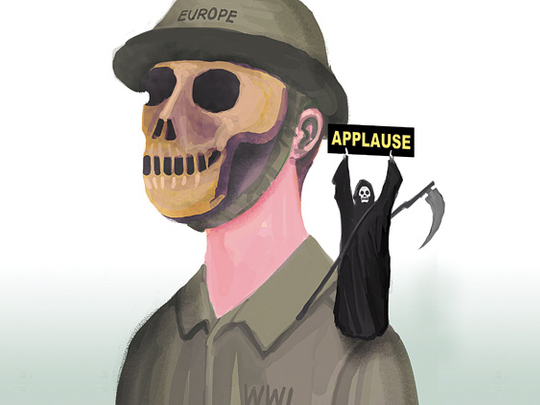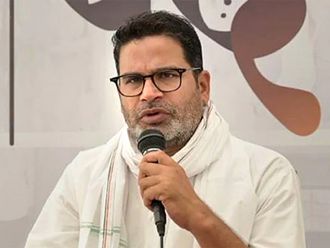
On July 17, the newly refurbished First World War galleries at south London’s Imperial War Museum finally reopened. One of the most poignant moments in the evening was when the director general of the museum, Diane Lees, broke down during her address while remembering her colleague Roger Tolson, who oversaw much of the renovation and who died early this year. It transformed the sepulchral hall, overhung with fighter planes, into what a First World War gallery must inevitably be: A place of remembrance and mourning.
With the last of the veterans dead, today we can remember only the process of remembering. When I was growing up in Kolkata in the 1980s, the war meant the trenches; the war poets and history books said so. And though I gradually realised that it involved seamen, labourers and women, its colour remained white. Only much later did I find out that British India contributed 1.4 million men to the war.
The centennial commemoration projects — from the museum’s thoughtful, more inclusive galleries to its film, Whose Remembrance?, from the BBC’s forthcoming The World’s Wars to the London-based Guardian’s multimedia documentary immersing us in the war’s multiple histories — will make us more aware of its global nature. In 1914, Britain and France had the two largest empires, spread across Asia and Africa, and an imperial war necessarily became a World War.
More than four million non-white men were recruited into the armies of Europe and the US. In a grotesque reversal of Joseph Conrad’s vision, thousands of Asians, Africans and Pacific Islanders were voyaging to the heart of whiteness and far beyond — to Mesopotamia, East Africa, Gallipoli, Persia and Palestine. Two million Africans served as soldiers or labourers; a further 1.3 million came from the British “white” dominions. The first shot in the war was fired in Togoland, and even after November 11, 1918, the war continued in East Africa.
A South African labourer said he went to war to “see different races”. If one visited wartime Ypres, one would have seen Indian sepoys, tirailleur Senegalese, Maori Pioneer battalions, Vietnamese troops and Chinese workers.
Today, one of the main stumbling blocks to a truly global and non-Eurocentric archive of the war is that many of these one million Indians, or 140,000 Chinese, or 166,000 West Africans, did not leave behind diaries and memoirs. In India, Senegal or Vietnam there is nothing like the Imperial War Museum; when a returned soldier or village headman died, a whole library vanished.
Moreover, as the former colonies became nation states, nationalist narratives replaced imperial war memories. Stories that did not fit were airbrushed. In Europe, communities turned to their own dead and damaged. Rudyard Kipling remembered the “Hindu sepoy in France” — “This man in his own country prayed we know not to what powers” — and in the next four years it will be interesting to see how he is remembered in his own country. However, just because Britain is obsessed with the war does not mean it is regarded as being equally significant or holds the same meaning in the former colonies: Sometimes it may have been the roar of battle, sometimes only a whisper in the fields.
But memory persists — silently, stubbornly. Last month, in a small archive in the former French colony of Chandernagore, near Kolkata, I found the bloodstained glasses of Jogendra Sen, the only non-white member of the Leeds Pals battalion, who was killed in 1916. And in my own family, I came across the carefully preserved Military Cross and other memorabilia belonging to a great-uncle who served as a doctor in Mesopotamia. Amnesia is not absence.
Perhaps the most startling discoveries in recent years are the more than 2,000 sound recordings made in German prisoner-of-war camps by the Prussian Phonographic Commission. One of the most heartbreaking is that of Mall Singh, in December 1916: “There was once a man. He used to eat butter in his native Hindustan. This man then came into the European war. Germany captured this man. He wished to return to India.” In the absence of an Indian Wilfred Owen, such voices pierce the silence. One has to move beyond conventional archives to recover such histories.
The recent global turn in First World War studies and commemorative events is partly propelled by Europe’s changing image of itself: We live in multicultural societies. Baroness Warsi, leading the colonial war commemoration in Britain, recently noted: “Our boys were not just Tommies — they were Tariqs and Tajinders too. They came from many nations and held many different faiths.” Warsi’s is an important caveat, as much to far-right parties keen to whiten the war as to ethnic and religious groups who may want to hijack its pluralities.
However, the Indian sepoy was always inferior in rank to the Tommy; in the Brighton Pavilion war hospital, on England’s southern coast, he was well looked after but fenced in. In Ypres, the South African Labour Corps was kept in a wired compound and Chinese labourers faced terrible racism.
Apparently, when a Caribbean soldier said he could not move because of frostbite, his officer stepped on his foot and said, “I am turning into Christ; I make the lame walk.” These are painful histories, but the past must be confronted.
There is an understandable impulse to retrospectively turn these men into heroes and martyrs, even though many enlisted to keep hunger at bay. Colonial war commemoration often slips into celebration (and is occasionally even used to recruit from ethnic minorities). In this narrative, we forget the valuable lessons of the war poets or indeed what the women in Punjab sang when their men left home in 1915: “War destroys towns and ports, it destroys huts / Graves devour our flesh and blood.”
While it is essential to challenge the colour of war memory, it is also important to keep a watch on the way it is being done.
— Guardian News & Media Ltd
Dr Santanu Das teaches at King’s College London and is the editor of Race, Empire and First World War Writing (2013).










